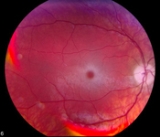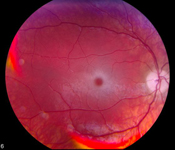
GM2-gangliosidosis, AB variant
Encyclopedia
GM2-gangliosidosis, AB variant is a rare, autosomal recessive metabolic disorder that causes progressive destruction of nerve cells in the brain and spinal cord. It has a similar pathology to Sandhoff disease
and Tay-Sachs disease
. The three diseases are classified together as the GM2 gangliosidoses
, because each disease represents a distinct molecular point of failure in the activation of the same enzyme, beta-hexosaminidase. AB variant is caused by a failure in the gene that makes an enzyme cofactor
for beta-hexosaminidase, called the GM2 activator.
tests of TSD patients revealed a few unusual false negative cases, patients who developed the disease, yet had normal enzyme activity. In other cases, parents who had not tested as carriers for TSD had children who nevertheless became ill with the symptoms of classic infantile TSD.
It was eventually determined that GM2 gangliosidosis could be caused by mutations on three distinct genes, one of which was an activator protein. Disease caused by a mutation that disables this protein was termed AB variant. In 1992, the GM2A gene itself was localized to chromosome 5, and the precise locus was determined the following year.

Signs and symptoms of GM2-gangliosidosis, AB variant are identical with those of infantile Tay-Sachs disease, except that enzyme assay testing shows normal levels of hexosaminidase A. Infantile Sandhoff disease has similar symptoms and prognosis, except that there is deficiency of both hexosaminidase A and hexosaminidase B. Infants with this disorder typically appear normal until the age of 3 to 6 months, when development slows and muscles used for movement weaken. Affected infants lose motor skills such as turning over, sitting, and crawling. As the disease progresses, infants develop seizures, vision and hearing loss, mental retardation
, and paralysis
.
An ophthalmological abnormality called a cherry-red spot, which can be identified with an eye examination, is characteristic of this disorder. This cherry-red spot is the same finding that Warren Tay
first reported in 1881, when he identified a case of Tay-Sachs disease, and it has the same etiology.
The prognosis for AB variant is the same as for infantile Tay-Sachs disease. Children with AB variant die in infancy or early childhood.

Mutations in the GM2A gene
cause GM2-gangliosidosis, AB variant. This condition is inherited in an autosomal recessive pattern.
The GM2A gene provides instructions for making a protein called the GM2 activator. This protein is required for the normal function of beta-hexosaminidase A, a critical enzyme in the nervous system that breaks down a lipid called GM2 ganglioside. If mutations in both alleles at this locus disrupt the activity of the GM2 activator, beta-hexosaminidase A cannot perform its normal function. As a result, gangliosides accumulate in the central nervous system
until they interfere with normal biological processes. Progressive damage caused by buildup of gangliosides leads to the destruction of nerve cells.
GM2-gangliosidosis, AB variant is extremely rare. In contrast with both Tay-Sachs disease and Sandhoff disease, in which many mutant polymorphic
alleles have been discovered, including pseudodeficiency alleles
, very few GM2A mutations have been reported. When AB variant is reported, in often occurs with consanguineous parents or in genetically isolated populations.
GM2A
is expressed in many tissues, and the GM2 activator protein has been reported to have other cellular functions. Because AB variant is so rarely diagnosed, it is likely that most mutations of GM2A are fatal at the embryionic
or fetal
stage of development in homozygotes and genetic compounds, and thus are never observed clinically.
Sandhoff disease
Sandhoff disease, also known as Sandhoff-Jatzkewitz disease, variant 0 of GM2-Gangliosidosis or Hexosaminidase A and B deficiency, is a lysosomal genetic, lipid storage disorder caused by the inherited deficiency to create functional beta-hexosaminidases A and B...
and Tay-Sachs disease
Tay-Sachs disease
Tay–Sachs disease is an autosomal recessive genetic disorder...
. The three diseases are classified together as the GM2 gangliosidoses
GM2 gangliosidoses
The GM2 gangliosidoses are a group of related genetic disorders that result from a deficiency of the enzyme beta-hexosaminidase. This enzyme catalyzes the biodegradation of fatty acid derivatives known as gangliosides. The diseases are better known by their individual names.Beta-hexosaminidase is a...
, because each disease represents a distinct molecular point of failure in the activation of the same enzyme, beta-hexosaminidase. AB variant is caused by a failure in the gene that makes an enzyme cofactor
Cofactor (biochemistry)
A cofactor is a non-protein chemical compound that is bound to a protein and is required for the protein's biological activity. These proteins are commonly enzymes, and cofactors can be considered "helper molecules" that assist in biochemical transformations....
for beta-hexosaminidase, called the GM2 activator.
Discovery
AB variant was first observed clinically shortly after the biochemical characterization of Tay-Sachs disease in 1969. The disease was initially thought to be caused by variant alleles of the HEXA gene, and Konrad Sandhoff designated it as AB variant in 1971. Enzyme assayEnzyme assay
Enzyme assays are laboratory methods for measuring enzymatic activity. They are vital for the study of enzyme kinetics and enzyme inhibition.-Enzyme units:...
tests of TSD patients revealed a few unusual false negative cases, patients who developed the disease, yet had normal enzyme activity. In other cases, parents who had not tested as carriers for TSD had children who nevertheless became ill with the symptoms of classic infantile TSD.
It was eventually determined that GM2 gangliosidosis could be caused by mutations on three distinct genes, one of which was an activator protein. Disease caused by a mutation that disables this protein was termed AB variant. In 1992, the GM2A gene itself was localized to chromosome 5, and the precise locus was determined the following year.
Symptoms and prognosis

Signs and symptoms of GM2-gangliosidosis, AB variant are identical with those of infantile Tay-Sachs disease, except that enzyme assay testing shows normal levels of hexosaminidase A. Infantile Sandhoff disease has similar symptoms and prognosis, except that there is deficiency of both hexosaminidase A and hexosaminidase B. Infants with this disorder typically appear normal until the age of 3 to 6 months, when development slows and muscles used for movement weaken. Affected infants lose motor skills such as turning over, sitting, and crawling. As the disease progresses, infants develop seizures, vision and hearing loss, mental retardation
Mental retardation
Mental retardation is a generalized disorder appearing before adulthood, characterized by significantly impaired cognitive functioning and deficits in two or more adaptive behaviors...
, and paralysis
Paralysis
Paralysis is loss of muscle function for one or more muscles. Paralysis can be accompanied by a loss of feeling in the affected area if there is sensory damage as well as motor. A study conducted by the Christopher & Dana Reeve Foundation, suggests that about 1 in 50 people have been diagnosed...
.
An ophthalmological abnormality called a cherry-red spot, which can be identified with an eye examination, is characteristic of this disorder. This cherry-red spot is the same finding that Warren Tay
Warren Tay
Waren Tay was a British ophthalmologist who was a native of Yorkshire.In 1881 Waren Tay first described the red spot on the retina of the eye that is present in Tay-Sachs disease. He reported this condition in the Volume I edition of the Ophthalmological Society, an organization in which he was a...
first reported in 1881, when he identified a case of Tay-Sachs disease, and it has the same etiology.
The prognosis for AB variant is the same as for infantile Tay-Sachs disease. Children with AB variant die in infancy or early childhood.
Etiology and pathogenesis

Mutations in the GM2A gene
GM2A
GM2 ganglioside activator also known as GM2A is a protein which in humans is encoded by the GM2A gene.- Function :The protein encoded by this gene is a small glycolipid transport protein which acts as a substrate specific co-factor for the lysosomal enzyme β-hexosaminidase A...
cause GM2-gangliosidosis, AB variant. This condition is inherited in an autosomal recessive pattern.
The GM2A gene provides instructions for making a protein called the GM2 activator. This protein is required for the normal function of beta-hexosaminidase A, a critical enzyme in the nervous system that breaks down a lipid called GM2 ganglioside. If mutations in both alleles at this locus disrupt the activity of the GM2 activator, beta-hexosaminidase A cannot perform its normal function. As a result, gangliosides accumulate in the central nervous system
Central nervous system
The central nervous system is the part of the nervous system that integrates the information that it receives from, and coordinates the activity of, all parts of the bodies of bilaterian animals—that is, all multicellular animals except sponges and radially symmetric animals such as jellyfish...
until they interfere with normal biological processes. Progressive damage caused by buildup of gangliosides leads to the destruction of nerve cells.
GM2-gangliosidosis, AB variant is extremely rare. In contrast with both Tay-Sachs disease and Sandhoff disease, in which many mutant polymorphic
Polymorphism (biology)
Polymorphism in biology occurs when two or more clearly different phenotypes exist in the same population of a species — in other words, the occurrence of more than one form or morph...
alleles have been discovered, including pseudodeficiency alleles
Pseudodeficiency alleles
A pseudodeficiency allele or pseudodeficiency mutation is a mutation that alters the protein product or changes the gene's expression, but without causing disease...
, very few GM2A mutations have been reported. When AB variant is reported, in often occurs with consanguineous parents or in genetically isolated populations.
GM2A
GM2A
GM2 ganglioside activator also known as GM2A is a protein which in humans is encoded by the GM2A gene.- Function :The protein encoded by this gene is a small glycolipid transport protein which acts as a substrate specific co-factor for the lysosomal enzyme β-hexosaminidase A...
is expressed in many tissues, and the GM2 activator protein has been reported to have other cellular functions. Because AB variant is so rarely diagnosed, it is likely that most mutations of GM2A are fatal at the embryionic
Embryo
An embryo is a multicellular diploid eukaryote in its earliest stage of development, from the time of first cell division until birth, hatching, or germination...
or fetal
Fetus
A fetus is a developing mammal or other viviparous vertebrate after the embryonic stage and before birth.In humans, the fetal stage of prenatal development starts at the beginning of the 11th week in gestational age, which is the 9th week after fertilization.-Etymology and spelling variations:The...
stage of development in homozygotes and genetic compounds, and thus are never observed clinically.

